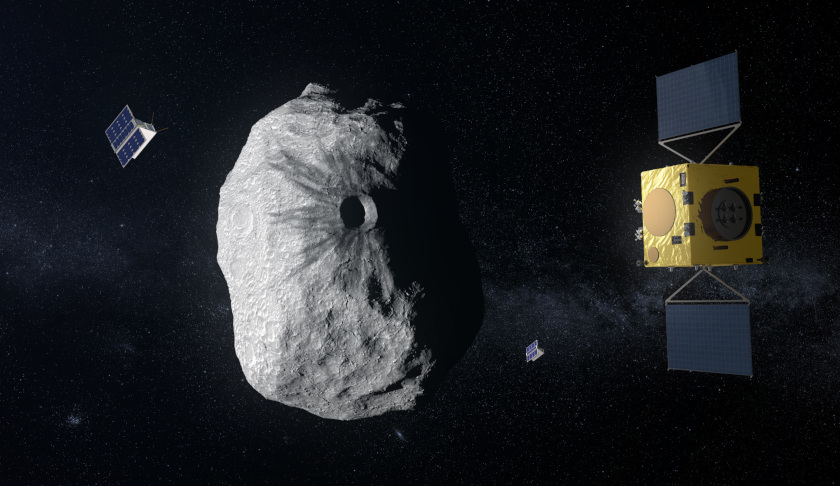
The spacecraft will carry two tiny CubeSats for deployment around – and eventual landing on – the Didymos asteroids. Each companion spacecraft will be small enough to fit inside a briefcase, as compared with the desk-sized Hera.
CubeSats are nanosatellites based on standardised 10 centimetre-sized units. Hera has room to deliver two ‘six-unit’ CubeSat missions to the Didymos asteroid system – a 780-metre diameter mountain-sized main body is orbited by a 160-metre moon, informally called ‘Didymoon’, about the same size as the Great Pyramid of Giza.
ESA Hera mission manager Ian Carnelli said, "We’re very happy to have these high-quality CubeSat missions join us to perform additional bonus science alongside their Hera mothership."
The first CubeSat companion is called the Asteroid Prospection Explorer (or APEX), and was developed by a Swedish/Finnish/Czech/German consortium. It will perform detailed spectral measurements of both asteroids’ surfaces – measuring the sunlight reflected by Didymos and breaking down its various colours to discover how these asteroids have interacted with the space environment, pinpointing any differences in composition between the two.
Paolo Martino, Hera spacecraft lead engineer, added, "The idea of building CubeSats for deep space is relatively new, but was recently validated by NASA’s InSight landing on Mars last November, when a pair of accompanying CubeSats succeeded in relaying the lander’s radio signals back to Earth – as well as returning imagery of the Red Planet."
In addition, APEX will make magnetic readings that will give insight into their interior structure of these bodies. Guided by a navigation camera and a ‘laser radar’ (lidar) instrument, APEX will also make a landing on one of the asteroids, gathering valuable data in the process using inertial sensors, and going on to perform close-up observations of the asteroid’s surface material.
The other CubeSat is called Juventas, developed by Danish company GomSpace and GMV in Romania, and will measure the gravity field as well as the internal structure of the smaller of the two Didymos asteroids.
"Carrying added instruments and venturing much closer to our target bodies, they will give different perspectives and complementary investigations on this exotic binary asteroid," Carnelli added.
Hera is set to be humankind’s first mission to a binary asteroid system. As well as testing technologies in deep space and gathering crucial science data, Hera is designed to be Europe’s contribution to an international planetary defence effort: it would survey the crater and measure orbital deviation of Didymoon caused by the earlier collision of a NASA probe, called DART. This unique experiment will validate the asteroid deflection technique referred to as kinetic impactor, enabling humankind to protect our planet from asteroid impacts.
Following this, the two CubeSats will have their designs refined and interfaces with their mothership finalised, in line with continuing design work on the Hera mission itself, which will be presented to ESA’s Space19+ meeting towards the end of this year, where Europe’s space ministers will take a final decision on flying the mission.
Receive the latest developments and updates on Australia’s space industry direct to your inbox. Subscribe today to Space Connect here.









